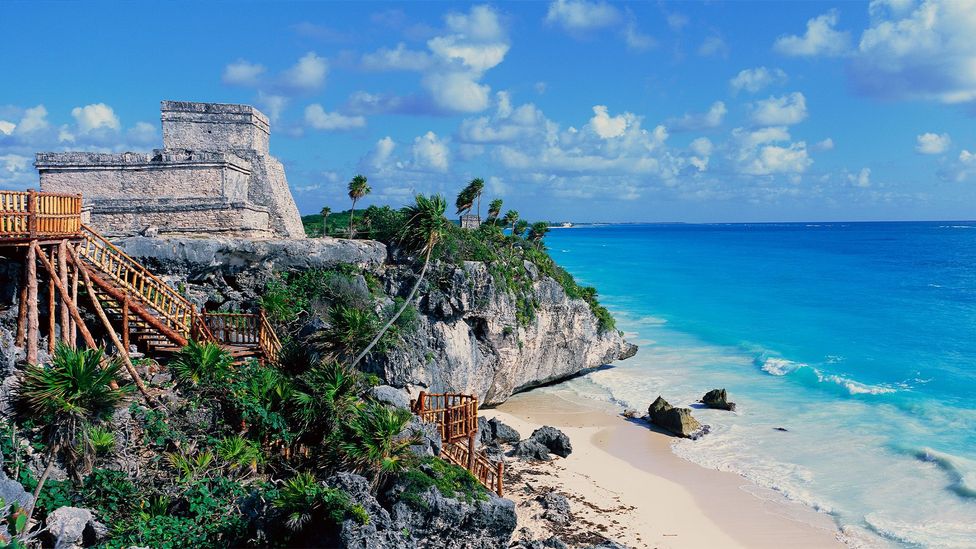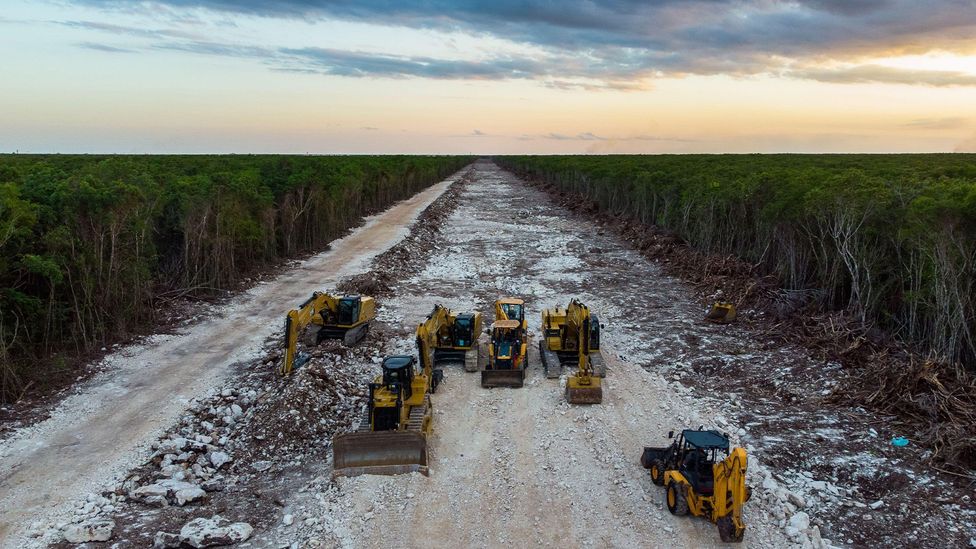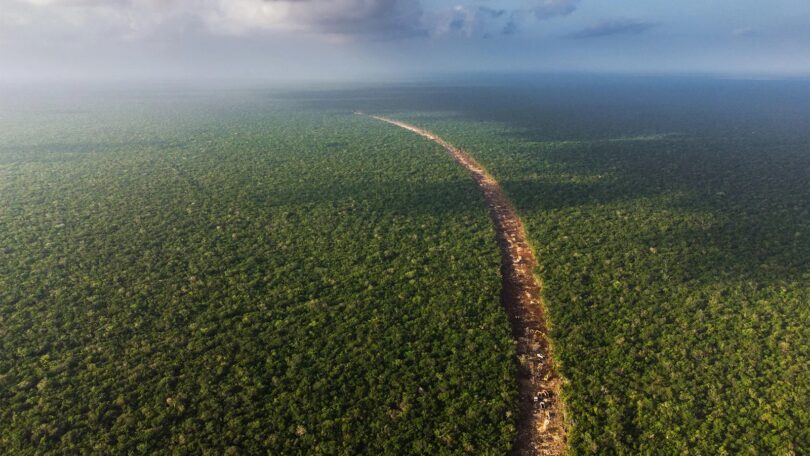Jessica Vincent
I first visited Tulum Pueblo as a backpacker in 2017. Located in Mexico’s south-eastern Yucatán Peninsula, the beach town is famed for its turquoise waters, eco-boutique hotels and clifftop Maya ruins. It is known as something of a green alternative to the skyscraper resorts of Cancún and Playa del Carmen to the north, and I spent the week doing beach yoga, turtle-spotting in the Sian Ka’an Biosphere Reserve, and biking along hot, dusty paths to jungle-clad cenotes believed by the ancient Maya to be portals to the underworld.
Since my visit, tourism in Tulum has boomed. What was once a strip of wild beach scattered with palm leaf-roofed meditation retreats is now one of Mexico’s most popular tourist destinations. In 2022, Tulum Ruins – one of the last cities inhabited by the Maya before the Spanish conquest in 1526, and the only one built overlooking the sea – received more than 1.3 million visits. That same year, the number of July and August visitors to Yucatán’s largest international airport, Cancún, were up by nearly four million compared to pre-pandemic numbers.
In response to the area’s staggering growth, Mexican President Andrés Manuel López Obrador ordered the military to build a new international airport in Tulum at breakneck speed. In December 2023, less than two years after construction began, Obrador inaugurated the airport with its first three inbound flights. While the new airport currently only receives domestic travellers, international flights are expected to begin in March 2024.
However, the opening of Tulum’s new airport is just one piece of a far-more ambitious tourism and infrastructure plan – one that Obrador has boldly called “the greatest construction project in the world”.

Tulum is the only ancient Maya site built overlooking the sea (Credit: Joseph Sohm/Getty Images)
On 15 December 2023, Obrador joined the inaugural journey from San Francisco de Campeche to Cancún aboard the new Tren Maya (Maya Train), a 1,500km rail route that, when complete, will stretch from near the Unesco-inscribed archaeological site of Palenque in the state of Chiapas to the city of Chetumal on the border with Belize. The train’s route is currently split into seven sections, which will be opening in stages. Sections one through four, which run 892km north-east from Palenque to Cancún, opened in December; while sections five through seven, which connect to the new Tulum airport and end at the city of Escárcega, are scheduled to open in February 2024.
When fully open to the public, the $28.5bn train line will span five states, 40 municipalities and 181 towns in south-eastern Mexico. It will connect tourist hotspots like Cancún, Playa del Carmen and Tulum to lesser-visited towns, biosphere reserves and inland archaeological sites across the Yucatán Peninsula through a mixture of direct stops and complementary bus transfers. Passengers will be able to choose from three different services: Xiinbal (“walking” in the Mayan language) trains are equipped with economy- and premier-class seating; Janal (“eating”) trains have a dining car serving hot meals; and P’tal (“accommodation”) trains include reclining seats and sleeping cabins for long-distance journeys.
Once fully operational, the Tren Maya is expected to run every two hours, offering a more reliable and comfortable way for travellers to see the Yucatan Peninsula than buses or colectivos (shared taxis), the main mode of public transport in south-eastern Mexico until now. The train also makes it easier to plan multi-day itineraries to some of the region’s harder-to-reach highlights, including Calakmul, Mexico’s largest protected forest, and spectacular Maya ruins like Uxmal, Palenque and Campeche, which have received a surge of interest since the discovery of the lost Maya city of Ocomtún in 2023. Historical cities like Merida and Izamal, home to beautifully preserved colonial architecture and ancient Maya dishes like poc chuc (grilled pork) and cochinita pibil (pulled pork shoulder), will also be along the route. Ticket prices range from 431.50 pesos (£19.95) to 1,862 pesos (£86.10) depending on the length of the journey and class.
But as a press release stated following the inauguration of the train’s first sections, the line isn’t just hoping to boost tourism, but also “[generate] economic opportunities for communities that have until now been marginalized from the benefits of mass tourism”.
Between the Tren Maya, Tulum’s new airport, the construction of an oil refinery in Tabasco and the creation of a coast-to-coast freight line said to rival that of the Panama Canal, the Mexican government will be creating hundreds of thousands of jobs in one of the country’s poorest regions. In addition to tourists, the Tren Maya will also carry cargo and commuters, facilitating trade and better connectivity across the peninsula.
“For a majority of the long-ignored people in Mexico’s south, the train is indeed not just a train. It’s a megaproject of hope,” wrote Étienne von Bertrab, who has been researching the proposed Tren Maya since 2020 and is working on a book about it.
But for all its proposed touristic and economic benefits, the Tren Maya has received a lot of criticism. Selvame del Tren – a campaign by environmental activists, cave divers and archaeologists to halt the project – says the rail route is destroying the Yucatán’s fragile ecosystem and endangering already at-risk animals like jaguars, spider monkeys and the 398 species of birds that live in the Yucatán jungle. In The Guardian, Sara López González, a member of the Regional Indigenous and Popular Council, even went as far as to call the Tren Maya a “megaproject of death” and “ecocide”.
“The train runs through the jungle, filling cenotes (sinkhole lakes) and underground rivers with concrete, without any studies,” said Selvame del Tren in an official statement. “We are not against progress. On the contrary, we consider development in the Peninsula as a great opportunity for social justice, economic reactivation and infrastructure improvement, but we seek to do it with full respect for the environment.”
When I arrived in the Yucatán in November, just weeks before the opening of the Tren Maya, the first thing I saw was a floor-to-ceiling image of an ultramodern white, teal and gold train speeding through a jungle. A strange cross between an Indiana Jones film poster and a commuter advert, the image also showed a dazzling Maya temple rising from the tree canopy, with the hashtag #TodosSomosTrenMaya (We’re All the Maya Train) above it. I’d come to walk the Camino del Mayab – a new long-distance trail for hikers and bikers to explore Yucatán’s cenotes, archaeological sites and Maya villages with minimum environmental impact – and hadn’t planned to stick around for the train’s opening. But the poster got me thinking: what did Mexicans think of their newest train line?
Everywhere I went that month, from villages in the Yucatán to cities in Oaxaca and Michoacan, opinions were split. Some, like my taxi driver in Mérida, Yucatán’s capital city, who worked 14 hours a day to provide for his family, thought that “anything that brings money into the state is a good thing”. When I pressed him to explain further, he responded: “We’ve been ignored by the government for too long. Poverty here is a problem. If that’s ever going to change, we need investment.”
Others, however, were deeply concerned about the effects on the environment and the disregard for Indigenous communities whose land had been bulldozed to make way for the train. In the Maya villages I walked through on the Camino del Mayab, many were mistrustful of the Tren Maya project, citing instances of families losing their land for lack of appropriate legal documents or being tricked into selling their properties for less than their worth.
“Not only has the train been built over cenotes, which could collapse at any time, it’s also displaced many Maya communities,” said Paulina Rios, a young marine biologist from Mexico City. “Maya people have had to move from their homes, where they have lived for hundreds of generations, for a train that they will probably never be able to ride [because it’s too expensive]. It doesn’t make any sense.”

Excavators have had to clear parts of the jungle in order to build the Tren Maya (Credit: dpa picture alliance/Alamy)
Concerns about the amount of public money spent on the train were also apparent during my trip, as the estimated $28.5bn price tag is roughly three times the original budget. “I just think the money could have been spent on more important things, like housing and conservation,” continued Rios. “Mexico has much bigger problems to focus on right now – a train that destroys our jungles and Indigenous communities isn’t a priority.”
There’s no denying that the investments being made into Mexico’s historically impoverished southern region and the speed at which projects like the Tren Maya and Tulum’s new international airport are being realised is nothing short of staggering. But whether all these ambitious projects will ever reach their full potential – and whether the financial gains will ever outweigh the environmental and social costs posed by the Tren Maya – remains to be seen.
Courtesy: BBC







